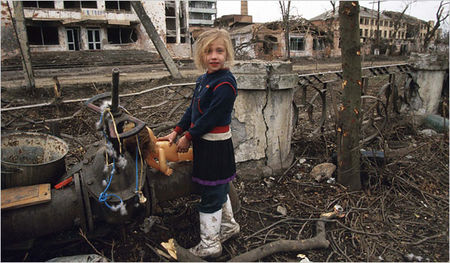The Angel of Grozny, Asne Seierstad
I just saw this in the NYT book review section - so glad to see Asne Seierstad has published another book following her first on Chechnya. Courageous Asne. Anna Polikovskaya would be proud of her.
A Chechnyan child amid the ruins of Grozny, 1995.
By PETER BAKER
New York Times, September 19, 2008
They steal, they hit, they kill dogs. And for New Year, they decorate the holiday tree in the backyard with the skeleton of a Russian soldier.
After some 14 years of war, terror and lawlessness, the children of Chechnya have been damaged in ways outsiders can barely fathom. Even now, with the war part of the war essentially over, Chechnya remains a place of hidden horrors, where life is fragile and exceedingly cheap.
The world long ago turned its gaze away, content that the big guns had been silenced and uninterested in peering beyond the illusion of stability that Vladimir Putin’s government in Moscow presents. But Asne Seierstad forces us to look again, to confront the reality of a savage place, to recognize that a broken, brutalized people have only begun to figure out how deep the wounds really go.
“The Angel of Grozny,” as it happens, comes at a grimly appropriate moment, as Russian tanks have once again been rolling through the tumultuous Caucasus, this time in the former Soviet republic of Georgia and its breakaway enclave of South Ossetia, not all that many miles from where Seierstad’s narrative plays out. As a French journalist friend who also once covered the region suggested in an e-mail message, you have a pretty chilling sense of déjà vu if you swap the words “Georgia” and “Chechnya.”
This remote part of the world, with its mix of nationalities, religions and languages, has long endured or rebelled against domination from Moscow, making it the tinderbox at the bottom of the Russian empire. But the trials of these people last far longer than any particular burst of shelling or cascade of bombing. The fear and dysfunction of daily life after the wars, or between them, are no less profound.
Seierstad, a Norwegian journalist who achieved international fame with the best-selling “Bookseller of Kabul” has gone back to Chechnya, long after most Western writers have moved on, and produced a gripping portrait of a forgotten war zone, looking past the superficial signs of recovery to find that while buildings may be reconstructed, souls are not so easily repaired.
Seierstad was one of many Moscow correspondents who trekked down south during the first Chechen war, which lasted from 1994 to 1996. She did not return until 2006, after the second Chechen war, launched by Putin in 1999, had largely ended, won by Moscow not so much through force on the ground as by buying off enough of the other side and giving converted separatists free rein to rule as they wished so long as they paid official fealty to the Kremlin.
Even now, Chechnya remains a land of disappearances and destitution, torture and travail, reprisals and repression. As Seierstad prepares to enter the region in disguise, she is advised to stop smiling because of course no Chechen woman would have much to smile about. “Keep your head down, frown and look unfriendly,” she is instructed.
She tells the stories of victims from both sides, the traumatized Chechens and the disfigured Russians. She writes about Iznaur, a Chechen boy who disappeared in 2000, not to return until 2007, tortured by a Russian lieutenant who assumed he had information about the separatists. The Russian hammered a nail into his shoulder, drove a pencil into his chest, pulled flesh out of his chest with tongs. “To get me to talk,” Iznaur explains.
Another victim of the same lieutenant, Seierstad writes, demanded to speak to a lawyer when he was seized. The soldiers happily gave him a phone, but with wires connected to his ear and finger, so that when he dialed, the current was activated and he shocked himself. The procedure was called zvonok advokatu — calling a lawyer.
On the other side, Seierstad travels to the home of a Russian soldier blinded and maimed by a land mine and essentially forgotten by the country he served. His mother cannot get the Defense Ministry to help the young man because records show he is still fighting in Chechnya. Even bringing her son to a military bureaucrat’s office to prove he is not does no good.
What’s most telling, though, are the twisted psyches of some of the people she meets, especially the children. She spends time in the home of Hadijat and Malik, who have taken in orphans, many of them troubled or beaten down. Although they make up only part of the book, Hadijat is the angel of Seierstad’s title, and in this rendering she earns the description. These are the children who bash rocks against dogs’ heads and recover the skeletal remains of a Russian sharpshooter for holiday decoration. One of the boys confides to Seierstad that he believes he has evil in his heart.
The book largely stays away from geopolitics, though the author skillfully depicts the fawning nature of Putin’s state-controlled television and includes a revealing visit with Putin’s hand-picked president of Chechnya, Ramzan Kadyrov, whose armed Kadyrovtsi are widely accused of terrorizing the countryside. Kadyrov denies having anything to do with the murder of the courageous Russian journalist Anna Politkovskaya, asserting that she was killed by her own patrons. “As a woman,” he says dismissively, “she should have stayed in the kitchen.”
Peter Baker is a Washington correspondent for The Times and a co-author, with Susan Glasser, of “Kremlin Rising: Vladimir Putin’s Russia and the End of Revolution.”

/https%3A%2F%2Fstorage.canalblog.com%2F33%2F16%2F508287%2F95344135_o.jpg)
/https%3A%2F%2Fstorage.canalblog.com%2F52%2F26%2F508287%2F95342137_o.jpg)
/https%3A%2F%2Fstorage.canalblog.com%2F42%2F99%2F508287%2F95342518_o.jpg)
/https%3A%2F%2Fstorage.canalblog.com%2F97%2F52%2F508287%2F55786848_o.jpg)
/https%3A%2F%2Fstorage.canalblog.com%2F33%2F68%2F508287%2F55786597_o.jpg)

/https%3A%2F%2Fstorage.canalblog.com%2F40%2F91%2F508287%2F98712362_o.jpg)
/https%3A%2F%2Fstorage.canalblog.com%2F38%2F76%2F508287%2F83379594_o.jpg)
/https%3A%2F%2Fstorage.canalblog.com%2F06%2F96%2F508287%2F83377251_o.jpg)
/https%3A%2F%2Fstorage.canalblog.com%2F92%2F69%2F508287%2F69301410_o.jpg)